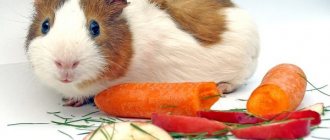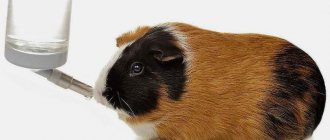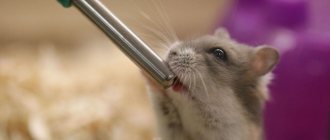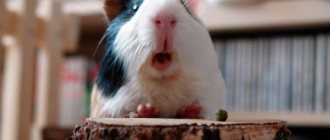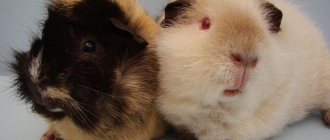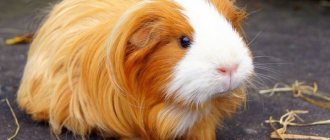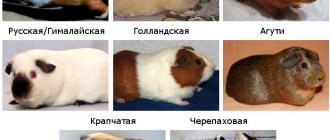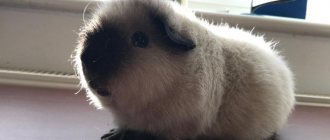Guinea pigs are animals that were bred by the Inca tribes living in South America in the territory of modern Peru and Bolivia. They still exist there in the wild. Selection work has made it possible to obtain many decorative breeds of guinea pigs that live with people and require care and attention. If your guinea pig gets sick, your veterinarian will help you understand the cause of the disease and provide treatment.
Guinea pigs are animals that were bred by the Inca tribes living in South America in the territory of modern Peru and Bolivia. They still exist there in the wild. Selection work has made it possible to obtain many decorative breeds of guinea pigs that live with people and require care and attention. If your guinea pig gets sick, your veterinarian will help you understand the cause of the disease and provide treatment.
Simple wire cutters
The most primitive device is very similar to ordinary scissors. Only one of its cutting surfaces is equipped with a small notch with a sharp edge. Using such a device is easy, provided you have some skill and experience. For young dogs, nail trimming is always stressful. They do not want to sit quietly, they strive to tear the paw out of the owner’s hands and in every possible way complicate the process. So Litbro.ru will not recommend such a gadget to novice dog breeders. The risk of causing serious physical injury to your pet is too great. Well, for experienced owners who have used similar tools more than once, nothing better can be desired. Cheap and very effective.
Cost – 35 – 72 rubles.
More advanced versions of hand cutters offer expanded functionality.
Although their main part, in the old fashioned way, is based on two cutting surfaces. Service additions imply only human convenience. Models with rounded ends, a container for cut claws and lighting have proven themselves very well. The fact is that some dogs have the habit of looking for clipped ends on the floor and eating them. Sharp, bent cuttings can damage the stomach wall and cause bleeding. A small “waste collection” effectively solves this problem.
Price – 636 rub.
Another gadget from the line of simple nippers has comfortable ergonomic handles that allow you to securely hold the tool while trimming nails.
This is important when the animal gets nervous and breaks out.
We pay attention to one more detail - the expansion spring. It fixes the cutting surfaces in the open state, which makes the operation somewhat easier.
Otherwise, the functions of the device duplicate all the features of its predecessors. To properly shorten claws, you must have the skill and achieve unquestioning obedience from your dog or cat.
Cost – 229.93 rubles.
Drinking regime and nutrition
It is more convenient to feed a guinea pig with ready-made concentrated food, at the rate of 20 g per kilogram of animal weight. If you give crackers, white bread or crispbread as a treat, you should know that such food is part of the finished food. Therefore, it must be given in accordance with the permissible volume.
It is worth adding 50 grams of succulent feed and fresh hay to the finished concentrated mixture. This type of feeding allows you to maintain the pig’s health at a high level, since all food has a balanced composition and is rich in vitamins and minerals.
Water is of great importance for rodents. Therefore, it is worth washing the sippy cup every day and pouring fresh, clean water. As vitamins, you can add ascorbic acid to the sippy cup at the rate of 30 ml per 100 ml of liquid. Vitamin C solution can be obtained from a veterinary clinic or pharmacy.
What to feed your guinea pig at home
It is important to maintain a balance between a conservative diet and its diversity. Reckless experiments (sudden changes in food or poor quality food) can cause disruption in the gastrointestinal tract and lead to the death of the pet.
Supporters of traditional feeding are confident that the optimal daily menu for a pig should include carrots, apples, white cabbage (very little), high-quality granulated food, parsley/dill + a lot of hay.
During the summer/autumn season, they add carrot tops, cauliflower, zucchini, cucumber from their garden, as well as environmentally friendly dried grass picked outside the city.
Vegetables, fruits, greens
To ensure that all vitamins are widely represented in the daily diet, succulent food must be alternated: ideally, from 3 to 5 types of vegetables/fruits and herbs.
Vegetable assortment:
- carrots, beets (and their tops); zucchini and pumpkin; cauliflower and white cabbage (in small doses); Bulgarian pepper; rutabaga and turnip; green peas (in pods); cucumber and tomato (preferably from your own garden).
Important! The latter vegetables are rarely given: cucumbers “wash out” calcium in large quantities, and store-bought tomatoes can be oversaturated with pesticides.
Assorted fruits and berries:
- apples, including dried ones; pears (very few - they are hard on the stomach); citrus fruits – rarely and little by little; berries (any, but infrequently).
The same list includes apricots, peaches, nectarines, plums and cherries, but with a limitation in quantity: these fruits contain a lot of sugars, and market fruits also contain chemicals.
Leafy greens such as watercress, head lettuce (without the base and core), Beijing lettuce (with the removal of the lower part that accumulates nitrates) and leaf lettuce itself (leaves without petioles) are allowed.
Also recommended:
- dill and parsley; greens of sprouted cereals (including oats and wheat); celery; leaves of garden and forest strawberries; currant, raspberry and mint leaves; plantain, dandelions, gooseberry, clover and other grass.
Do not forget to thoroughly wash everything picked in the forest and in the country.
Grains, nuts in feed
Pigs are herbivores, not granivores, which is why pelleted/grain mixtures cannot be the mainstay of their diet . The granules usually contain a lot of calcium and proteins, which contribute to the deposition of stones in the bladder and cause other ailments of the kidneys and liver.
In addition, being carried away by pellets, the animal ignores green food and hay, which leads to overeating, constipation and the development of malocclusion. Also in granules and mixtures there is an increased percentage of fat and sugar, which are quickly converted into adipose tissue, since the pig does not know how to store reserves behind the cheeks or in the hole (like other rodents). And this is a sure path to diabetes and obesity.
Another danger lies in the flavoring additives with which factory-made food is stuffed - preservatives and flavorings a priori cannot be beneficial for living beings. Other ingredients from industrial feeds are also recognized as harmful to guinea pigs: meal (including bone/fish meal), molasses, honey, seeds and yeast.
Important! If you want to switch your pig to natural food, do it gradually. You should not suddenly remove granulated food from the menu of growing, pregnant or lactating rodents (this can undermine their health).
Grain, corn and cereals
For a sedentary pig, this is a source of excess carbohydrates, which instantly turn into fat, enveloping its internal organs, making it difficult for them to function. All cereals are contraindicated for guinea pigs due to the increased concentration of starch (up to 80%): the animal’s intestines cannot break it down due to the lack of necessary enzymes.
Undigested starch triggers the fermentation process, during which gases are constantly formed in the rodent's intestines, accompanied by bloating and colic.
Dried fruits
Dried fruits are full of natural sugars, harmless in small doses, but dangerous in large doses . If you often give your animal dried fruits, be prepared for the fact that he will develop diabetes, suffer from toothache and skin rashes.
In addition, dried fruits in excessive quantities disrupt the functioning of the intestines and prevent proper grinding of teeth. By swelling, dry fruits give a feeling of fullness, in which the animal is less interested in hay, which is responsible for both the activity of the gastrointestinal tract and the grinding of teeth.
Seeds and nuts
For a guinea pig, these are unnatural foods due to their excessive fat content: for example, sunflower seeds and peanuts contain up to 50% fat. By focusing on nuts, the rodent gains excess weight and feels unwell because it eats less hay and digestion worsens.
It is not surprising that at 3-4 years of age (with excess fat consumption), the guinea pig begins to have uncontrollable diarrhea. If you really want to feed your pet seeds, be sure to remove the husks and give no more than 1-4 seeds per week.
Important! The transition to natural food is made gradually. To avoid damage to the digestive system, reduce the amount of pelleted food very slowly (over several weeks).
Vitamins and minerals
The rodent's body is not capable of producing vitamin C, so you will have to give it 5-25 mg of ascorbic acid, dissolving it in water. Such feeding is excluded if the purchased food contains a rich multivitamin composition. Guinea pigs cannot live without salt: 0.5 g per day for a young animal, and three times more for an adult.
Mineral stones act as suppliers of salts and calcium, especially in demand in winter (with a decrease in the proportion of lush greenery responsible for microelements).
Inexperienced “pig farmers” may be intimidated by the sight of a pet eating its own droppings. Meanwhile, this is an absolutely normal phenomenon: this is how guinea pigs move vitamins K and B through the digestive tract (they are absorbed only when they enter the stomach again).
Refuse boiled water in favor of filtered or still (bottled) water. The water is changed when it becomes dirty, as pieces of food often get into it . One pig will need a 250 ml drinker, which should always be filled.
Don't forget that females nursing or bearing young need more fluid.
Why doesn't my guinea pig eat, drink, or go to the toilet? Methods to combat this problem
Typically, guinea pigs live 5-8 years, but there are cases when these animals lived up to 10 years or more. Living with older pets is a bittersweet experience. You've been through a lot together and grew very comfortable with each other. Older pigs are usually calm and better behaved than younger pigs, they can sit quietly and enjoy your company.
We invite you to familiarize yourself with: Fur seal, marine mammals, photos, species
The average lifespan of a guinea pig is 5-7 years. I think 3-4 is middle aged, 5-6 is older, 7 and up is pretty darn old. There are many things you can do to help your pig live a longer and more comfortable life. The trick is to notice problems as soon as possible. Most of the following recommendations apply to pigs of any age, but a little more for older pigs.
Remember how your guinea pig looks and behaves normally, this will make it easier to immediately notice that something is wrong. Old people often cannot fight diseases, but like guinea pigs in their prime, they bounce back just as quickly. Body parts wear out and may fail completely.
Pay attention to your water consumption, it is important. If your guinea pig suddenly drinks more or much less than usual, check the water bowl first. Sometimes drinkers leak, or the balls get stuck and prevent water from flowing out.
Replace the drinker if necessary and watch for changes in water consumption. If the water bowl is working properly but water consumption remains abnormal, your guinea pig has a problem and should contact your veterinarian
Sometimes drinkers leak, or the balls get stuck and prevent water from flowing out. Replace the drinker if necessary and watch for changes in water consumption. If the water bowl is working properly but water consumption remains abnormal, your guinea pig has a problem and should contact your veterinarian.
Older pigs should have their front teeth examined regularly to ensure they are growing evenly and evenly. Sometimes teeth become more fragile and break easily. Broken teeth usually grow back within a week or so, but trimming may be necessary if the teeth grow jagged or uneven. Your pig should be able to eat even with one tooth, cut juicy food into smaller pieces, this will make it easier for her to eat.
If your guinea pig has difficulty chewing but the front teeth look fine, the molars (back teeth) may be out of alignment, overgrown (hooked), or crooked. You will need to see a veterinarian for an examination and teeth trimming. Guinea pigs sometimes require regular trimming to keep their teeth straight and their bite correct.
You may notice changes in the eyes of older pigs. As a form of cataract, the eyes gradually become hazy, bluish or whitish, and opaque. In this case, it's not a bad idea to go to the vet, but in the case of cataracts, there is not much that can be done. Cataracts are usually not painful and guinea pigs easily adapt to decreased vision. If one or both eyes suddenly become white and opaque, inflamed, bulging or bulging, take immediate action.
Stress and lack of thirst
If your guinea pig is not drinking water and has lost weight, stress is a likely cause. This is especially true for animals that have just been purchased. A change of environment or moving to a new place of residence has a negative impact on the psychological state of the pet. He is nervous in anticipation of something new, which is a strong stress factor. In order to return the guinea pig’s psyche to normal, you should pay it as much attention as possible, try to cuddle it, and feed it something tasty. After a while, the pet will adapt and start drinking water.
If several guinea pigs lived in the same cage at the same time, the death of one of the neighbors could become a stress factor. Guinea pigs take loss hard, so during such periods they require increased attention.
Some other common stress factors for guinea pigs:
- constant loud noise around the cage (especially often observed in rooms where there are children); sudden change in climatic conditions; change of food or diet; pungent smell, light.
All these factors lead to the fact that the guinea pig may refuse water. To prevent this condition, it should be quiet near the cage with the guinea pig, there should be enough lighting, and there should be no strong odors. Your pet should be introduced to new foods gradually.
Pneumonia in a guinea pig
Pneumonia in a guinea pig can be infectious or a complication of a cold, rhinitis, bronchitis or pulmonary edema. Most often, pneumonia is observed in weakened animals and young animals in the spring and autumn. Pneumonia can be caused by keeping furry pets in a draft, in a damp or cold room, changes in temperature and humidity, and improper transportation. Concomitant factors are an unbalanced diet, a lack of vitamin C in the animal’s body, and a lack of sufficient amounts of fresh herbs, vegetables and fruits in the small animal’s menu.
Acute and chronic pneumonia occurs in guinea pigs. The acute form is dangerous due to its rapid current. The pet has a high fever, intoxication and exhaustion. He may die within 3-4 days from the onset of the disease. In advanced cases, treatment is not always effective. The chronic form does not have a clearly defined picture. At the same time, it significantly shortens the life of your beloved pet. Pneumonia reduces the immunity of the funny animal, which often begins to suffer from infectious and contagious diseases and loses a little weight.
The development of pneumonia in a guinea pig is indicated by the following characteristic symptoms:
- refusal of food and water;
- dry or wet cough, depending on the form and stage of the disease;
- heavy, hoarse breathing with whistling and gurgling, the animal experiences shortness of breath, and when inhaling, the sides characteristically rise;
- inactivity, lethargy, a depressed animal sits, ruffled, in one place or lies, does not respond to treats or the owner’s voice;
- the small animal sneezes, grunts, sniffles, viscous purulent discharge is observed from the nose and eyes;
- the nose is covered with dried crusts of pus, the eyes are red, swollen, the palpebral fissure sticks together and purulent contents accumulate in the corners of the eyes;
- the coat is dull, tousled, stuck together;
- The guinea pig sleeps often and for a long time.
It is necessary to treat your pet at the first signs of illness under the supervision of an experienced specialist. An insidious pathology may have hidden symptoms. Often there is a significant improvement, followed by a relapse, deterioration of the condition and death of the beloved animal.
Treatment
If your guinea pig wheezes, your veterinarian will prescribe a course of antibacterial or sulfonamide medications. These include: “Baytril”, “Sulfazin”, “Sulfadimezin”. Medicines are used in a course only after determining the animal’s body’s response to the drug. Simultaneously with antibacterial therapy, it is necessary to give the patient probiotics: “Linex”, “Vetom”, “Bifidumbacterin”.
Every day it is necessary to clean the animal's nose by cleaning the muzzle from crusts of pus and rinsing with a chlorhexidine solution. After drying the nasal planum, it is recommended to blow Streptocid powder into each nostril twice a day.
In case of eye inflammation, it is necessary to wash the animal’s eyes twice a day with sterile saline solution, followed by instillation of anti-inflammatory drops “Tsiprovet”, “Tsipromed”.
To eliminate a cough, you need to give your pet expectorant mixtures of anti-inflammatory herbs or give the animal a drop of Bromhexine baby syrup.
To restore immunity and increase the body's resistance to colds, the pet is prescribed an increased dose of ascorbic acid with glucose, gamavit and echinacea tincture.
An increased amount of green grass, vegetables and fruits should be introduced into the diet of a sick pet. In case of complete refusal of food, the animal must be fed paste-like food from an insulin syringe without a needle. Small portions should be given 5-6 times a day.
How much should you drink when sick?
Doctors often recommend drinking plenty of fluids while prescribing medication. But it is not always clear what is hidden under this concept. How much water should you drink to avoid fluid deficiency in the body? Physiological specialists have calculated how much a person with coronavirus infection needs to drink. According to research and calculations, on average, for every degree of temperature increase, it is necessary to increase the intake of liquid in the amount of 10 ml per kg of weight. Thus, if you have a high fever (approximately 39°C), you will need half a glass or a glass of water every hour.
Interesting! Japanese scientists studying coronavirus infection have concluded that you need to drink a few sips every 15 minutes. This helps to avoid drying out of the mucous membrane and reduces the risk of infection in the respiratory tract.
Deadly diseases of guinea pigs
Despite a strong immune system, your pet can get sick. The reason may be lack of care, lack of vitamins or a sudden change in diet. The most dangerous diseases that lead to the death of a pet are viral infections.
Enteritis
The lack of vital nutritional components (hay, grass) causes an infectious disease, the causative agent of which is Escherichia coli. The bacillus develops rapidly in the animal’s intestines and digestive organs.
A bloated belly feels hard to the touch
First symptoms:
- Bloating.
- Refusal of food and drink.
- Fever.
- Diarrhea with blood clots.
- Wheezing in the lungs.
- Paralysis of limbs.
- Body convulsions.
Without prompt veterinary intervention, the animal dies from loss of fluid in the body.
Salmonellosis
A virtually incurable disease. The source of infection is animals, food with a large amount of protein or water contaminated with salmonella bacilli. The first sign is:
- Complete refusal of the animal to eat and drink.
- Profuse salivation.
- Diarrhea.
- Intermittent breathing.
- Heat.
- When examining the abdomen, bloating is observed.
Without the help of a specialist, the rodent dies within a day. At an early stage of the disease, the pet can be saved; delay involves euthanasia. It must be remembered that the disease is contagious to humans. In any case, disinfection of the room and cage is required.
Pseudotuberculosis
An extremely dangerous disease transmitted through contaminated food or drink. The disease caused by bacteria is fleeting and can affect all inhabitants of the cell. Manifests itself in symptoms:
- Loss of appetite.
- Lethargy.
- Increased body temperature.
- Severe diarrhea.
- Convulsions progressing to paralysis of the legs.
Pseudotuberculosis cannot be cured. The animal dies from lack of fluid in the body and paralysis.
Pneumonia
Pets with weakened immune systems and vitamin deficiencies are prone to the disease. Pathogens include disgusting rodent maintenance and poor quality nutrition, as well as infection from a sick owner.
The pig may not eat at all or eat little by little
The first signs of respiratory disease are:
- Refusal of food.
- Weakness and indifference.
- Frequent drinking.
- Discharge of pus through the nasal sinuses, which the animal tries to get rid of on its own by wiping its nose on the bedding, or trying to clear its nose with its paw.
- Shallow, rapid breathing.
- Heat.
- Short convulsions.
When characteristic symptoms appear, the rodent must be isolated from people and animals. A timely visit to the veterinarian and quick medical assistance can save your pet.
How many times a day should you feed your guinea pig?
She is fed two to three times, provided that hay, as well as bowls of food and water, are constantly present in the cage. If the pig does not immediately try the fresh portion, it will definitely finish it after some time.
Juicy food is given, as a rule, in the first half of the day, and in the second half the emphasis shifts to dry food . With three meals a day, the rodent is given 1/3 tablespoon of dry food at one time, with two meals a day - half a tablespoon.
Having eaten the main provisions, the pig switches to dry grass: not only can it not starve, but it should not. An empty stomach causes intestinal stagnation.
Important! European veterinarians resort to euthanizing a starving pig if more than 18 hours have passed since its last meal. It is believed that irreversible changes have occurred in the animal's body.
Liquid intake rate
Do not worry ahead of time, because increased thirst does not always mean the presence of a serious pathology in the cat’s body. Veterinarians do not have water consumption standards. Indicators depend on many factors - age, physiological state, climatic conditions, nutrition, etc.
The amount of moisture required for the body can be calculated approximately: 0.03 ml of liquid per 1 gram of cat’s body weight. Moreover, you need to count not only water, but also wet food, milk, broth, etc.
Veterinary experts say that each cat has its own water consumption rate. You can determine that she has enough fluid by the animal’s behavior. If the cat is cheerful and active, eats with appetite and does not lose weight, then everything is in order with his health.
Possible diseases
In some cases, the reluctance to drink water is due to the fact that the guinea pig has excess fluid in its body, which leads to internal swelling. Typically this condition is a symptom of the following diseases:
- heart attack;
- urolithiasis disease;
- pneumonia;
- problems with blood vessels;
- renal failure.
With such ailments, the guinea pig’s body tries to get rid of the accumulated liquid in it, so the pet does not drink anything.
Important! If the rodent suddenly becomes lethargic and does not eat or drink anything, it is necessary to show it to a doctor as soon as possible, since without timely medical care the pig may die.
To reduce the likelihood of your pet developing various diseases, compliance with the care and maintenance conditions necessary for these rodents will help:
- A properly selected balanced diet.
- Avoiding stressful situations.
- Creating a comfortable environment in the cage.
- Maintaining physical activity.
- Creating a suitable climate in the room where the cage is located.
Norm
About 250 ml is enough for one pet. Although, as a rule, there is no specific dose. Each animal consumes as much liquid as it needs, depending on its age and nutrition. The main thing is not to have enough.
You need to put a drinker in the cage, preferably a special ball or rod drinker, which differ in the type of valve. There is no difference, the first ones are just more popular
You should also pay attention to the fastenings. Plastic ones that are attached to the grille are the best option.
There are also suction cups and wire ones. But they have their drawbacks: the first ones do not hold securely, while others create noise while drinking.
It is not recommended to simply pour water into a bowl. While running, an animal can easily turn it over, get wet and catch a cold.
Females who are expecting babies and nursing ones drink more than usual. Often leftover food gets into the water and it quickly spoils. Therefore, it must be changed daily. You can use filtered, still bottled water, but the temperature should be at room temperature. You can boil water, cool it to the required degrees and then pour it. Raw tap water, even settled water, is not suitable for drinking.
Some owners see that the animal does not seem to need it and stop giving water. But this cannot be done. All guinea pigs need to drink, some not enough, some more. A lack of fluid in the diet can lead to malfunctions of the pet’s internal organs.
What not to feed guinea pigs
The list of prohibited products is extensive.
It included:
- potatoes and cereals (in any form); dairy products, including cow's butter, cottage cheese and cream; pickles and smoked meats; winter cucumbers, tomatoes and watermelons; confectionery products, including chocolate and marshmallows; meat, fish and eggs; burdock, spinach and sorrel; green onions and salad mustard; mushrooms, chestnuts and any inflorescences; garlic, horseradish and radish; table salt, sugar and sweet tea; bakery and pasta products.
It is not recommended to give guinea pigs branches of certain trees: buckthorn, oak, rowan, larch, hornbeam, elm, willow, spruce and pine. But since you can’t do without wood, feel free to include shoots of apple, plum, hazel, currant, cherry, hawthorn, apricot, gooseberry (without thorns), pear and blueberry in your diet.
The guinea pig hardly drinks.
Details Parent category: Rodents Category: Guinea pigs Published 02/29/2016 12:11
The guinea pig drinks very little. Is this normal and what should I do?
Many lovers of this cute animal are concerned about this issue.
But in principle, you don’t need to do anything and here’s why. In nature, guinea pigs do not consume very much water, since they feed mainly on wet food in the form of succulent grasses. And at home, the volume of water is replenished with fruits and vegetables.
And yet, there should always be water in the cage, clean and fresh. It is advisable to change the water daily. The animal itself understands how much water to drink and when. A drinking bowl of about 250 ml is sufficient for one pig.
Why might a guinea pig not drink water?
A guinea pig may refuse water if the diet has been changed or more fresh vegetables, fruits and fresh juicy greens have been added to it. Also, the reason for refusing water may be the winter period; it has long been noted that in the cold season, a rodent consumes less liquid than in the summer.
A newly purchased pig may also refuse water, food and exercise little. There is no need to do anything about this, since the animal is in a state of tension due to its reaction to an unfamiliar environment, to which it has yet to get used, and refusing water is a natural reflex.
To help your pet quickly adapt to a new place, you can put hay next to the bowl so that the animal can hide in it and not be afraid of its surroundings.
Dry grass should not only provide shelter, it is the pig's primary food and should be present throughout the year. The optimal amount of hay for one pig should be approximately 60 grams (1 cup) per day. Carrots, apples, beets, cucumbers and other vegetables and fruits can be used as succulent feed.
What to do if your pig doesn't drink from the water bowl?
The drinking bowl with water should be at such a height that the pig can easily reach it, that is, at the level of the muzzle. Also make sure that the drinking bowl is in good working order, does not become clogged, and that water always flows from it. Some animals prefer to drink from a bowl rather than from a drinking bowl, so you need to offer your pet this option.
And it doesn’t matter whether the animal drinks water or not, clean water should be present in its home at all times.
It is impossible to imagine a healthy guinea pig dying from dehydration if there is water in the cage
It is important to know that a guinea pig should not be force-fed or syringed. The pig knows whether it needs to drink water or not.
Don't underestimate the little rodent.
We also must not forget that if the pig is pregnant or nursing babies, then she drinks much more water than usual.
- < Back
- Forward >
Diseases accompanied by lack of thirst
A guinea pig refuses water only when there is an excess of fluid in its body. This situation is often observed due to edema. Diseases leading to edema in guinea pigs:
- kidney diseases, especially urolithiasis; cardiovascular diseases, previous heart attack; pulmonary edema due to pneumonia.
With these diseases, the guinea pig's defense mechanism turns on. The less water she drinks, the faster all the moisture will leave the body.
When your guinea pig does not drink water or go to the toilet, you may suspect urolithiasis. It is a metabolic disorder in the body, resulting in the formation of stones of various natures in the kidneys. In the future, these stones cause a number of symptoms:
- change in urination; pain syndrome; loss of appetite; vomit.
The main symptom is refusal of water. In the future, kidney stones can move along the ureter, thereby injuring it and clogging the lumen. A characteristic sign of a stone in the ureter is bloody urine. Before the stone passes from the kidney into the ureter, it can provoke an attack of renal colic.
If treatment is not carried out, the stone then moves down the ureter and enters the bladder. The guinea pig begins a period of imaginary well-being, as the stone simply floats in the bladder. Well-being continues until a stone blocks the outlet of the bladder. In this case, a clear clinical picture appears:
- the animal completely refuses water and stops going to the toilet; sharp, pronounced pain syndrome (the animal rushes about and cannot find a place for itself); enlargement of the abdomen due to stretching of the bladder; severe intoxication of the body (repeated vomiting, lethargy).
If you do not visit a veterinarian and do not begin urgent treatment, there is a risk of death.
Another disease in which a guinea pig does not drink water and is lethargic is a complication of myocardial infarction - heart failure. This disease occurs more often in adult animals. Heart failure is a consequence of untreated myocardial infarction or improper adherence to veterinarian prescriptions.
Main manifestations of heart failure:
- lethargy and apathy of the guinea pig, rare monotonous movements around the cage; swelling of the whole body, especially the abdomen and limbs; complete refusal of food and food; rare trips to the toilet; dry ears; deterioration of coat condition.
This disease is incurable. Therefore, it is better to prevent it. Prevention consists of preventing stress in the animal, proper balanced nutrition, and the possibility of active life. Guinea pigs that lead a sedentary lifestyle are at risk. Therefore, inside and outside the cage, the pet should have the opportunity to run and move around.
By the way, do you know how to determine the breed of a guinea pig? Look, it's interesting!
Tama the Cat: Train Station Master
This happened in the early 2000s, when the unprofitable Kishi station in the Japanese city of Kinokawa was almost closed due to unprofitability. Residents, of course, protested, but it is unlikely that their efforts would ultimately be crowned with success. The situation was saved by a local cat named Tama, who loved to bask in the sun near the train station. The station manager noticed how enthusiastically passengers reacted to this couch potato and gave him the official position of caretaker. The cat was given a uniform cap, a badge and a monthly salary in the form of free food.
The duties of the newly minted minister included advertising functions. He greeted passengers, allowed himself to be petted, and was always somewhere on the platform. It must be said that this policy very quickly led to commercial success. Tourists began to come to Kishi station just to look at the railway cat and take pictures with him. From that moment on, there was no further talk about closing the station.
But the unusual cat's career did not end there. In 2008, Tama became a supervisor and was charged with monitoring the performance of professional duties by staff. That same year, the cat was knighted. Another year later, according to the project of the famous designer Eiji Mituku, the railway included in the schedule a train dedicated to the legendary animal. The carriages were painted with views of Tama, the locomotive was decorated with his muzzle, and meowing signaled the opening (closing) of the doors. But this did not become the crown of the cat’s career.
A year later, Tamu was appointed third party of the railway company, entrusted with the post of executive director. By his old age, it was already difficult for him to work every day, and the management allowed the elderly cat to come to work 3 days a week.
Tama died at the ripe old age of 14. But even after this, the career did not end. Posthumously, the cat was elevated to the rank of Eternal Station Master, thus perpetuating his memory. After all, over the years of work, this four-legged employee has brought considerable income to his company. The tourist flow through the station increased to 300 thousand people annually, and the financial indicator amounted to more than 1.1 billion Japanese yen.
The company's management did not want to accept the loss of such a profitable and already promoted advertising brand. Tama was replaced by Nitama (the second Tama). True, later with the third cat there was an overlay. He was found at Okayama Station and offered a position in Kishi. But the owner did not agree to the move. Next came Yontama (the fourth Tama), who had already had to undergo a special training course before taking her place on the platform of the railway station.
And the flow of tourists wanting to take a photo with the legendary heirs of the first Tama still does not dry out.
I like2I don't like
Why does my pig drink a lot of water?
Reasons why your guinea pig drinks a lot of water. It's possible she might have a fever. Another motive that causes thirst is that for a long time the food contains dry food: grain mixtures, hay, and there is little fresh grass and vegetables in the diet.
At home, especially in winter, when the air becomes dry due to heating, the animals' need to drink may increase.
It happens that a pig drinks water just to keep itself busy. In this case, you need to put the drinker only for a while.
Alternatively, the drinking bowl is leaking. Or if the cage is small, then the rodent can drink water out of nothing to do. This means that you need to change it to a more spacious one, check the sawdust under the drinker to see if it is wet. Sometimes the pig drinks carelessly, spilling some water.
Drinking too much can be caused by stress. If the pig has recently appeared in the apartment and the environment is new and unusual for it.
What to do
Drinking a lot is not harmful. Pigs differ from other rodents in that they drink large amounts of liquid and relieve themselves, especially if there is little succulent food. But it often happens that animals simply spill water - by accident or while running due to shaking, it spills itself. To prevent this from happening, you need to place a ceramic stand under the spout of the drinker, pour filler onto the bottom of the cage and cover it with sawdust.
And don’t worry about your pet drinking a lot. If the animal is healthy, it regulates its own drinking rate. More succulent food in the diet will reduce the dose consumed.
First aid and treatment
Urgently show the animal to the ratologist. It is necessary to quickly find out the cause and prescribe the correct treatment. There is not a doctor of this qualification in every city, and he does not always see you. The pet has at most 16 hours. Therefore, you need to be able to feed a guinea pig artificially. Force feeding begins when the hunger strike lasts more than 8 hours. There are several feeding options:
- Children's fruit or vegetable puree without prunes. The serving is 20% of the usual diet.
- Soaked food in grass granules.
- Wheat bran porridge or rolled oats with water are suitable.
- You can use baby porridge without milk.
- If the animal cannot take a bite, you need to grate vegetables, for example, pumpkin or carrots, on a fine grater.
The pet must be fed through an insulin syringe without a needle with a cut off tip. Thus, food will enter the intestines, albeit in a small dose. You can add a little ascorbic acid to increase the level of vitamin C in the body. Feeding should be done every 3 hours. Even if after a few days the guinea pig begins to eat on its own, take it to the doctor as soon as possible.
Diagnostics
Don't hesitate if you see an animal acting strangely.
Take him to the veterinarian immediately - only he will be able to recognize the disease.
But, of course, you must be able to distinguish a sick rodent.
Diseases found in guinea pigs are divided into several types:
- defects caused by heredity;
- a number of parasitic diseases;
- diseases caused by improper feeding, as well as the composition of food feed;
- infections;
- all kinds of mechanical injuries.
